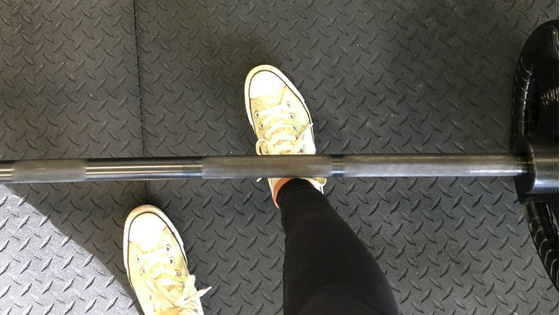Does Working Out Make You Pee? Pelvic Floor PT To The Rescue!
In my experience, the pelvic floor has always been a sort of mythical unicorn, especially when it comes to yoga and fitness.
I’ve had countless yoga teachers tell me to engage my pelvic floor, without really explaining how or why. In yoga teacher training we gloss over the idea of mula bandha (aka pelvic floor lock), but it’s admittedly something that I never got a full grasp on. Maybe you’ve experienced an OB/GYN or some magazine article telling you to do kegels, but rarely do these articles tell you how. As if we’re all just supposed to magically and intuitively know how to do a kegel. It’s not like this is a super comfortable topic to discuss at a family dinner (or in a blog post for that matter).
Don’t even get me started on the amount of students and clients I’ve had who:
A. Have resigned themselves to the fact that now that they’ve had kids, they can no longer jump or lift heavy weights because it makes them pee their pants.
B. Are struggling with issues like diastasis recti (abdominal separation) and can’t seem to find good answers.
C. Have absolutely NO clue what sort of exercise is appropriate for them during and post-pregnancy. They either unknowingly do something that causes harm, or are so afraid that they do nothing at all.
Then there are people like me. Never had a baby, and kind of freaked out about the things I’ve heard floating around the internet in regards to all of these topics.
Oh, and TMI alert: sometimes when I do a lot of jumping or cough really hard, I pee a little too.
WTF? This isn’t supposed to happen to me. I don’t have kids. I work in the fitness industry. I should have a super strong core AND pelvic floor right? It’s not necessarily that simple. And thanks to the Instagram story of a colleague, I discovered that there are actually some very well respected pelvic floor physical therapists that specialize in working with people on issues just like this. The best part: there happen to be some really great ones in Chicago where I live!
Not only was I able to get some solutions for myself in just one visit, but pelvic floor PT Sarah Haag of Entropy Physiotherapy & Wellness agreed to an interview that answers all the most common questions about pelvic floor health. If you take one thing from this article, it’s this. When it comes to all things related to pelvic floor dysfunction, especially urinary incontinence:
It’s very common but NOT normal.
Sarah and I took some time to go over some of the most common questions I’ve heard/wondered about the pelvic floor. If you’re looking for some answers too, check out our Q&A!
Q: Why is pelvic floor health important even if I don’t have kids or plan on it?
A: Most of us use our pelvic floor every day and don’t even know it. It helps us with maintaining posture, continence, sexual function, and bowel function. Your pelvic floor is just another muscle, but most of us don’t even know what’s normal, and some don’t even know that it’s there. It should be able to contract and relax and we should be able to coordinate it so it can do its job, which is keep us continent, among other things.
Q: I sometimes pee when I do things like jumping, lifting, coughing, or laughing. Why?
A. Incontinence is a huge thing. If you’re experiencing it, that’s a sign that there’s something imbalanced down below, and it might be a pelvic floor issue. Either too weak, too tight, or a coordination issue. It’s not necessarily as simple as just doing kegels. Some people are plenty strong. They’re having trouble with that coordination. There’s even a degree of it that’s normalized for elite athletes. Stress incontinence happens when there is an increase in intra-abdominal pressure. The urethra moving too much can also contribute to stress urinary incontinence.
Q: How do I even go about finding a pelvic floor physical therapist?
A: You can start by going to APTA.org, and search by location and specialty. If you can find someone in your area that’s good, but not everyone is gonna be a perfect fit. Whatever therapist a person ends up with is one that’s helping them meet their goals. If stuff isn’t changing in 3-5 visits, there needs to be an honest conversation. Physical therapy shouldn’t suck. It shouldn’t hurt more, and shouldn’t make you feel bad.
Q: There are no pelvic floor physical therapists in my area? What can I do?
A: It depends on what state you live in. We’re happy to talk and do online consultations–it’s not physical therapy, more just education. Maybe recommend what kind of doctors you should see. You can earn a lot, try some things, and if it makes the changes you want, awesome. If not we can help with referrals too.
Q: How can I be sure I’m getting solid advice from my doctor? Mine tells me it’s just part of being a woman and to do kegels.
A: When it comes to pelvic floor stuff: incontinence, pain with intercourse, even a lot of bowel issues, all of those are things that pelvic floor PT might be able to help with. And so if you bring it up with your doctor (and I do think that you should), unfortunately there are still some doctors who are like “Eh, it’s part of being a woman, just do kegels.” When you’re in the fitness world, there are some things you do in a particular way for a reason to get certain body parts to work. And doing kegels sounds great, but a lot of people do them wrong. Really sitting down and trying to figure out: is your pelvic floor strong or weak? Or is it uncoordinated?
Wanna take a break and learn more about pelvic floor exercises with Sarah? Check out this video!
Q: How do I incorporate my pelvic floor when I lift weights?
A: Whether you’re going to lift weights or do a moving class, you want the pelvic floor to be part of that thing. For example, in a squat: Make sure that you’re staying long through your spine. Make sure you’re breathing. Exhale on the way up. If you’re doing kegels or pelvic floor exercises, it should become a part of the party. Train it separately and then let it join.
Q: If I continue to do the exercises that cause me to leak urine am I going to cause more damage to my pelvic floor?
A: No. Much like anything, for example double unders or lifting, there are some days when you’re like “BAM! I was amazing!” and everything’s falling into place. We have good days and bad days and that’s includes with continence. So if it’s a pelvic floor coordination/breathing/impact thing and you’re on a bad day you might notice more leakage. You can chalk it up to a bad day and try again tomorrow. You’re not really making it worse. But if you’re not trying other things to make it better it probably won’t get better.
Q: What if I have a pelvic organ prolapse? Will certain activities cause more damage?
I’m not 100% sure what the case is with a prolapse. Clinically, what I can say with pretty good confidence is that most of the time, when women are feeling more of that pressure, they can alter their pelvic angle, or take a little rest and put their legs up a wall and the feelings can go away. So I think that’s an indication that you’re not making the prolapse worse, you’re just increasing your symptoms and you can modify those.
Q: What exactly is pelvic organ prolapse?
A: I want you to imagine that you are camping in you’re in your tent. But then the drunk from the campsite next door comes and falls into your tent. So he’s in your tent, but there’s still that wall of tent between you and the person that’s not supposed to be there. That’s what a prolapse is. So the passive support, different ligaments and connective tissues that are holding things up where they’re supposed to be start to stretch or be less supportive. This sometimes allows those organs to ‘fall into the vagina’ and down towards the opening.
Q: How do I know if I’m at risk for a pelvic organ prolapse?
A: The more vaginal deliveries you’ve had, the more likely you are to have one. People who lift a lot standing on their feet all day may also be more at risk. There are also things that play in like genetics, for example how strong the connective tissue is. Something to remember: If you are fit and healthy going in to a pregnancy, and you know that afterwards there is help for whatever outcome for whatever you need, that’s good. Even if you get it, know that there’s help, know that there are options. There’s a great organization called Global Women’s Health Initiative that can help with this.: here’s a link to learn more: http://www.gwhi.org/
Q: Is diastasis recti something a pelvic floor PT can help with?
A: Yes! The most annoying piece of advice I have: Don’t be scared and give it time. After you’ve had a baby, everything has been stretched out and kind of deflated. It’s connective tissue that kept stretching and stretching. Over time it’s gonna get somewhat better. Most women are going to be fine. Whenever I work with women, I want to know: Do you feel like you’re having some kind of functional issue? Like incontinence, back pain, feeling unstable or trouble picking up your kids? Or are you just not liking how it’s looking? Because that’s a legit concern. Sometimes it has to to with what’s happening under the skin but sometimes the skin is the slow part, and that has nothing to do with the diastasis.
Q: Are there certain exercises that will make my diastasis better or worse?
A: I have not found any studies anywhere of exercises that will make diastasis worse. It might make it look funnier while you’re doing the exercise. But as far as something that’s going to actually make the separation wider, it took a baby on the inside for 40 weeks stretching to make that happen. It doesn’t seem logical that you can actually stretch it further by a particular exercise.
Much like the pelvic floor, you’re using your abs when you’re sitting up straight. You’re using your abs when you pick up the groceries. you’re using your abs when you’re walking on the treadmill. Don’t be afraid of it. If you notice bulging or things that do not look good, there are usually things you can change about the way you’re breathing or using your abs to make that more efficient. Then it looks better too which people like. There’s some stuff we can do to help, but there’s not an exercise that will magically approximate those tissues. There are also a lot of very commercial things available and lots of videos on YouTube that will scare the living crap out of you. Don’t go there.
Q: What’s the most important thing to know about working out during/post pregnancy? Are there any myths you wanna bust?
A: What we need to know is that during pregnancy, there are so many things, even in the medical world, that have never been born out by a study. There are many studies we could do because all women are all different. Each pregnancy is really an individual experience. It’s a tough thing to study. There are no exercises that we know of that will prevent a diastasis of the abdominal muscles. There are no exercises that we know of that are inherently bad for a pregnant woman, outside of specific medical issues they may be having. There are activity recommendations for women, but what we’re finding is that women are not active enough period. It’s almost like we’ve scared them into not being active.
Q: What else do you really want people to know when it comes to pelvic floor health?
A: If something isn’t working well, or if you’re peeing your pants that’s not normal. If you’re having pain anywhere, but also especially in the pelvis, that’s not normal and there’s help for it. It doesn’t have to be a medical issue. If you’re concerned about a medical issue, go get cleared by your doctor. Once you’re cleared of those things, a PT really can help. You really can get better. Should you happen to run into a doctor or a PT or anyone else who says you can not get better, thank them for their words, but I could continue to look for someone because we can all get better. Especially when it comes to pelvic things.
Nobody wants to be like, “Yup I pee my pants. Anyone else?” Urinary incontinence can actually have a more detrimental effect on quality of life than stuff like diabetes and cancer. When it’s incontinence it’s embarrassing. You don’t get the same kind of support. You might start to withdraw. And then fitness and general health declines. It can become very isolating and very detrimental. It’s not “no big deal”, and it’s not “just normal, live with it.” There’s something that can be done. It’s really interesting how easy it is for people to say “just stop that” and that shouldn’t be the answer. We can fix this.
Whether you’ve experienced any of these pelvic floor issues yourself, or coach people who have, I hope you found some helpful information for yourself and/or your clients. Sarah has included a few additional resources on these topics below. You can also learn more about how you can work with her or get additional questions answered by visiting the Entropy Physiotherapy website.
Additional resources:
https://www.acog.org/Patients/FAQs/Exercise-During-Pregnancy
Reaching out for help is often necessary when it comes to feeling better in your body. I might not be able to personally work with you on your pelvic floor health, but I can help with the body image concerns that often go along with it.







